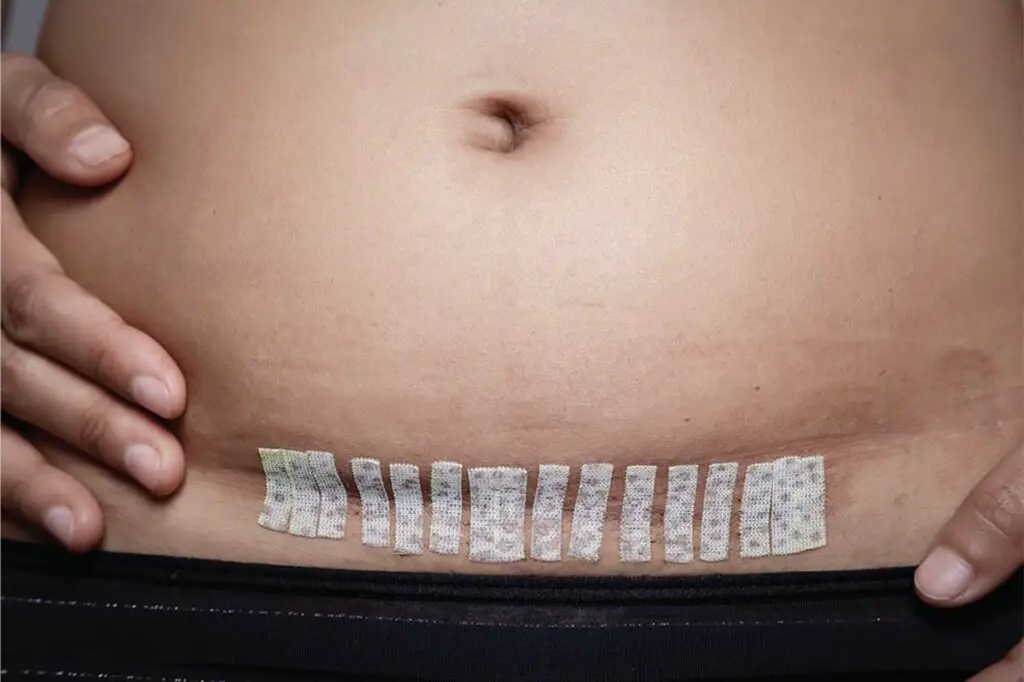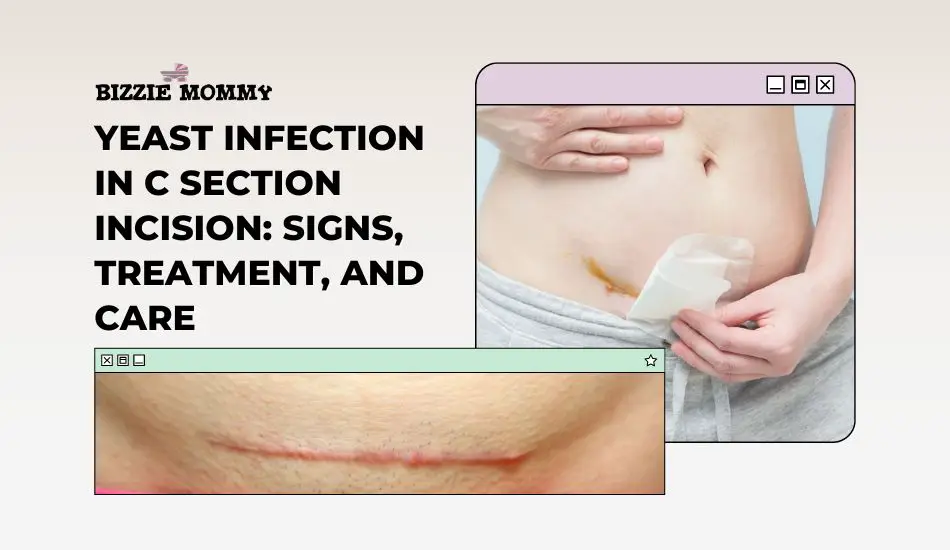A c-section incision is one of the toughest things a woman’s body can undergo. Post-surgery, a woman is prone to infections like yeast infection. The good news is it is treatable.
Normally yeast grows all over the human body, including the gut, mouth, and private parts. A yeast infection can occur after a c-section when yeast grows excessively due to a moist incision site. No need to panic, post-cesarian yeast infection is preventable and curable.
What Is Yeast Infection?
Yeast infection is a common disease among women that occurs due to an overgrowth of fungal yeast. It’s a painful condition for a woman, especially if it occurs right after a c-section when the body is already weak.
There are multiple types of yeast infections according to the location of the infections’ growth. The most common location of a yeast infection is a genital yeast infection. It is characterized by genital irritation, discharge, and itchiness. Scientifically known as candidiasis, it affects at least three out of every four women all around the world.
It is commonly misconstrued as a sexually transmitted infection. The chances of acquiring yeast infection are high during the period of initial sexual activity. Oral sex is also considered one reason for the transmission of infection.
If you are suffering from a c-section incision yeast infection, recovery will take time. Post-delivery, the body is weakened and needs time to increase its natural immunity. The moist incision wound allows yeast to grow excessively. You will need to seek proper medical treatment if a yeast infection occurs in your incision.
Yeast Infection in C-Section Incision

Yeast infection can occur on any body part that has excessive yeast growth. When your incision from the c-section starts to develop a yeast infection, there are several factors at play.
One of the major causes of c-section yeast infection is broad-spectrum antibiotics. These are used during the cesarian procedure to combat any infections by killing bacteria. Unfortunately, they kill healthy bacteria along with bad ones. This allows the yeast fungus to grow excessively.
Another common cause of yeast infection is an open incision. Surgical sites are prone to multiple infections. Also, the wound dressing keeps the incision moist, creating a perfect breeding ground for yeast to grow in massive amounts. With no good bacteria to kill the overgrowth of yeast, the incision becomes an active infection site.
Symptoms
Post c-section yeast infection has symptoms similar to that of a genital yeast infection. However, they are more deadly as now the surgical wound is involved. A genital yeast infection can cause discomfort, bleeding, and discharge. A surgical site infection can also show telltale signs as follows:
Your first clue is the redness of your c-section scar and burning pain in the abdomen. It is easy to mistake the post-delivery symptoms with the symptoms of yeast infection. Your hint here is to see whether the symptoms subside or get worse with each passing day.
The redness is accompanied by itchiness, pain, swelling, and bumpy skin. Now is the time to get some medical care treatment so as not to let it spread any further.
Treatment
Call your doctor immediately if you see any signs that may signify an infection. Some of the common treatments for yeast infection include:
The main thing in the treatment of yeast infection is to remove moisture from the wound. Once the wound is dry, it will heal quickly. You may also use antifungal powder, or powder spray to combat fungus overgrowth. It makes the wound dry up in a short period if applied regularly.
Fighting yeast is the job of the healthy bacteria that are killed by c-section antibiotics. You can repopulate good bacteria with the use of probiotic supplements. They can escalate the growth of good bacteria to fight the fungal infection completely. You can also follow a nutrient-rich diet to boost your immunity and power to fight infections. Yogurt and other fermented foods are on top of the list.
You also need to increase your dietary vitamin C intake. Indulge in a diet of green vegetables and citrus fruit consumption. It is ideal for increasing the body’s natural immunity.
Lastly, prevention is key. Genital bleeding occurs after the delivery. If you are not careful with your pad and let your private parts remain too moist, the yeast can overgrow. This leads to a genital yeast infection. Maintaining proper care is the best prevention.
After Care
You need to take extreme care after your delivery, especially if you develop a yeast infection afterward. If you want to avoid reoccurring yeast infections or other women-centric infections like urinary tract infections, you need to give the healing process time.
Not only do you have to heal from a yeast infection, but your body is coming back to normal after nine months. It has gone through several hormonal and physical changes and has borne the burden of cesarian delivery.
Recurrent yeast infections can be serious. I understand that the pain of a yeast infection on top of the surgical pain is massive. However, taking over-the-counter medicines to relieve yourself may only worsen the situation. Talk to your specialist and heed only his/her advice in this matter.
Another area of important self-care is practicing caution with sexual activity. It is understandable that after a while, you may want to resume sexual relations. It is vital that you wait for a full six weeks following delivery. This is a crucial time for your physical health, and the psychological aspects of postpartum should not be ignored either. It is better to delay sex until you feel adequately refreshed, energized, and in a healthy mental state once again.
Personal hygiene has a massive role to play in avoiding yeast infections. You must clean yourself regularly to keep infections at bay. Taking warm showers regularly can also have a positive impact on your overall health.
Try to be easy on yourself. You have just given birth and a beautiful human came out of you. You need to relax and avoid worrying about your house chores. If you get over-exerted and do not take care of yourself, the infection may resurface. Especially if the incision hasn’t healed properly.
Get in touch with your healthcare provider as soon as possible if a yeast infection reoccurs. You don’t want it to develop into something more serious. So be vigilant and take all the necessary steps required to prevent and treat this infection. Remember, a proper diet, adequate rest, and diligent hygiene can keep your immune system strong and infection at bay.
Know that You’re Not Alone
As mentioned earlier, a vast majority of women around the world face yeast infections at some point in their life. Yeast overgrowth may occur in many areas of the body, including around the c-section incision. If you are facing this infection, you are not alone.
Prevention is always best. If you are a mommy-to-be, you should start taking measures now. There are a few simple steps you can take to prevent yeast infection.
Aim for a Fit Dressing
The surgical site is already moist due to wound drainage and can become very wet if the dressing is too tight. A tight dressing doesn’t allow the wound to dry. This allows yeast growth to thrive. To avoid that from happening, ensure the dressing is fit properly and is not too tight or loose.
- Prioritize Regular Hospital Visits
Try to have a healthy pregnancy and take care of yourself as much as you can. This includes regular visits to your doctor. Women who take care of themselves in the pre-natal stages of pregnancy develop fewer yeast infections post-c-section.
- Focus on Strengthening Your Immune System
Another important thing usually missing from the infection talk is the immune system. Your immune system fights infections and keeps harmful bacteria at bay. If your immune system is weak, good bacteria are unable to fight viruses and harmful toxins. Resultantly, you can develop an infection. To fight off a yeast infection, you need to keep your immune system strong through diet, exercise, and rest.
If you develop a yeast infection after a c-section, don’t worry, it is treatable.
Get Treated Today!
Yeast infection is common after a c-section and is treated successfully all around the world. The better option here is to try to prevent the infection.
A vast majority of women struggle through this issue, unfortunately, the journey is full of misconceptions and apprehensions. Remember to use a proactive approach. Look out for symptoms like redness, swelling, and pain at your incision site. If the moist area has allowed yeast overgrowth, try taking probiotics, increasing vitamin intake, and abstaining from sex.
You just need to take good care of yourself and take all preventive measures to avoid a yeast outbreak. If you do encounter a c-section yeast infection, don’t panic. Get yourself to a real doctor, and you’ll be on the mend soon.

